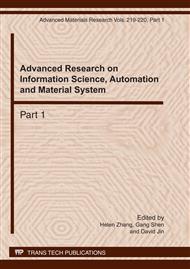[1]
Hansen J, Nussbaum M: Application of Bismuth-telluride thermoelectrics in driving DNA amplification and sequencing react ions. Proceedings of 15th International conference on Thermoelectrics, Vol.1(1996), 256-258.
DOI: 10.1109/ict.1996.553312
Google Scholar
[2]
T.M. Teo1, S. Lakshminarayanan1 and G.P. Rangaiah1: Performance Assessment of Cascade Control Systems, Journal of The Institution of Engineers, Singapore, Vol.45(2005), pp.27-38.
Google Scholar
[3]
Huang, B., S.L. Shah and K.E. Kwok: Good, Bad or Optimal? Performance Assessment of Multivariable Processes, Automatica, Vol.33(1997), pp.1175-1183.
DOI: 10.1016/s0005-1098(97)00017-4
Google Scholar
[4]
Ko, B.-S. and T.F. Edgar. Performance Assessment of Cascade Control Loops, AIChE J., Vol.46(2000), pp.281-291.
DOI: 10.1002/aic.690460208
Google Scholar
[5]
Krishnaswamy, P.R., G.P. Rangaiah, R.K. Jha and P.B. Deshpande: When to Use Cascade Control, Ind. Eng. Chem. Res., Vol.29(1990), pp.2163-2166. Morari, M., and E. Zafiriou, E. Robust Process Control. Prentice Hall, NJ. (1989).
DOI: 10.1021/ie00106a033
Google Scholar
[6]
Desborough, L., and T.J. Harris: Performance Assessment Meas ures for Univariate Feedback Control, Can. J. Chem. Eng., Vol.70(1992), pp.1186-1197.
DOI: 10.1002/cjce.5450700620
Google Scholar
[7]
Desborough, L., and T.J. Harris: Performance Assessment Measures for Univariate Feedforward/Feedback Control, Can. J. Chem. Eng.,Vol. 71(1993), pp.605-616.
DOI: 10.1002/cjce.5450710413
Google Scholar
[8]
Krishnaswamy, P.R. and G.P. Rangaiah. Role of Secondary Integral Action in Cascade Control, Trans. IChemE., Vol.70(1992), pp.149-152.
Google Scholar
[9]
Kary Mullis: The Unusual Origin of the Polymerase Chain Reaction,Scientific American, (1990),pp.56-65.
Google Scholar
[10]
Robert F. Service:The Incredible Shrinking Laboratory,Science, Vol.268(1995), pp.26-27.
Google Scholar
[11]
A.F. Markham: A Tool for Molecular Medicine, British Medical Journal, Vol.306(1993), pp.441-447.
Google Scholar
[12]
Stephen.P.Naber. Molecular Pathology: Diagnosis of Infectious Disease.Vol.331(1994),pp.1212-1215.
Google Scholar
[13]
Harris, T.J., F. Boudreau and J.F. MacGregor: Performance Assessment of Multivariable feedback Controllers, Automatica,Vol. 32(1996),pp.1505-1518.
DOI: 10.1016/s0005-1098(96)00108-2
Google Scholar
[14]
Harris, T.J., C.T. Seppala and L.D. Desborough: A Review of Performance Monitoring and Assessment Techniques for Univariate and Multivariate Control Systems, J. Proc. Cont., Vol.9(1999), pp.1-17.
DOI: 10.1016/s0959-1524(98)00031-6
Google Scholar


